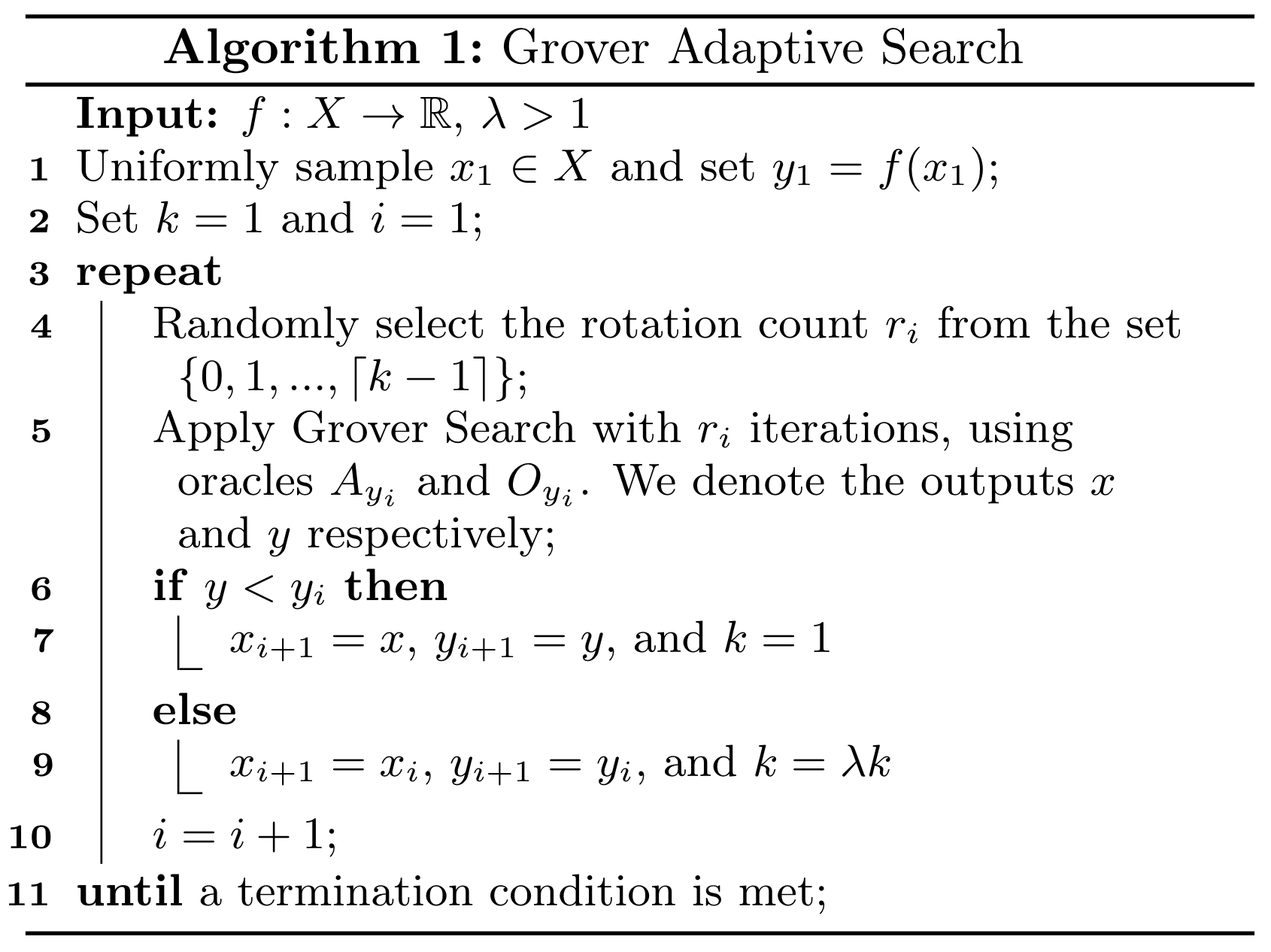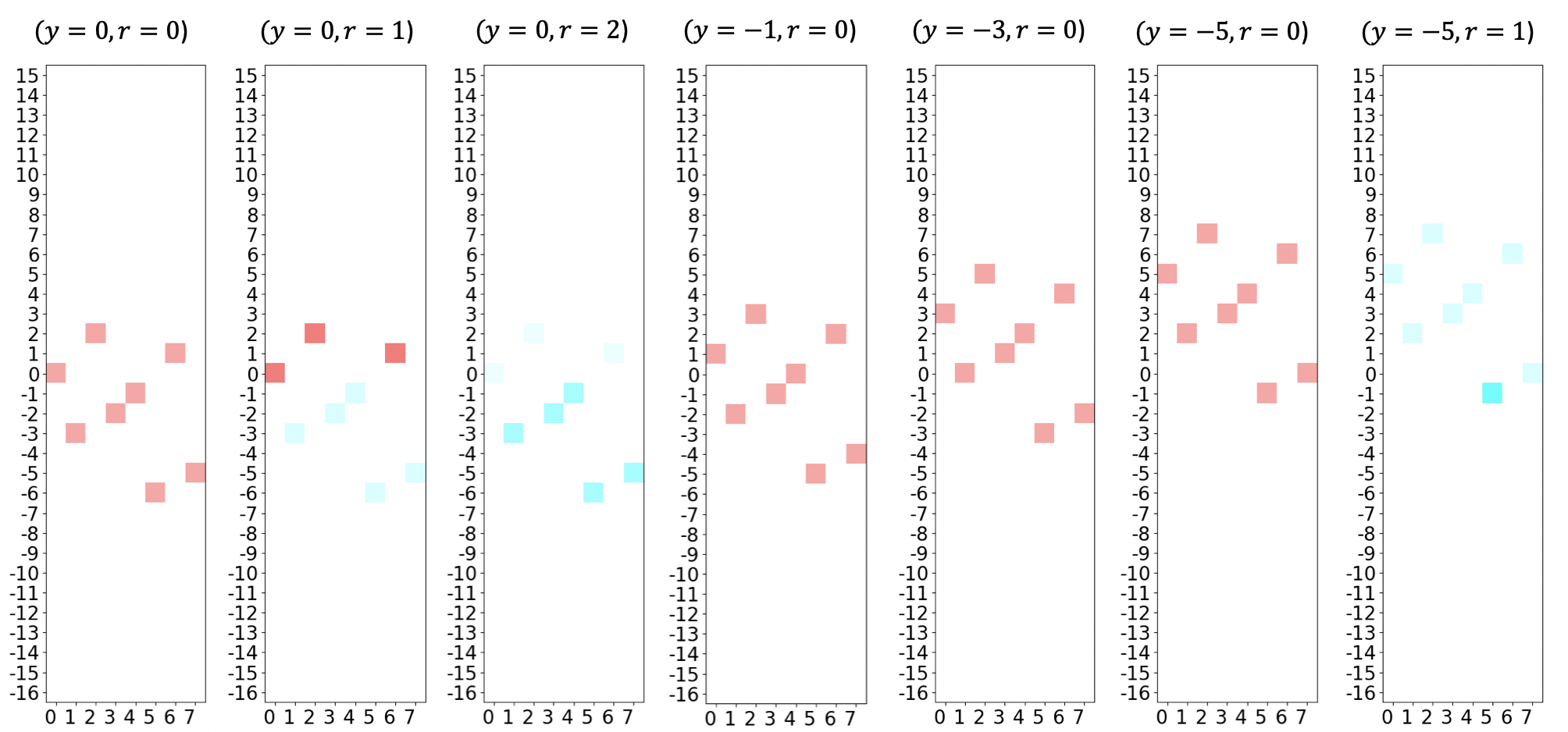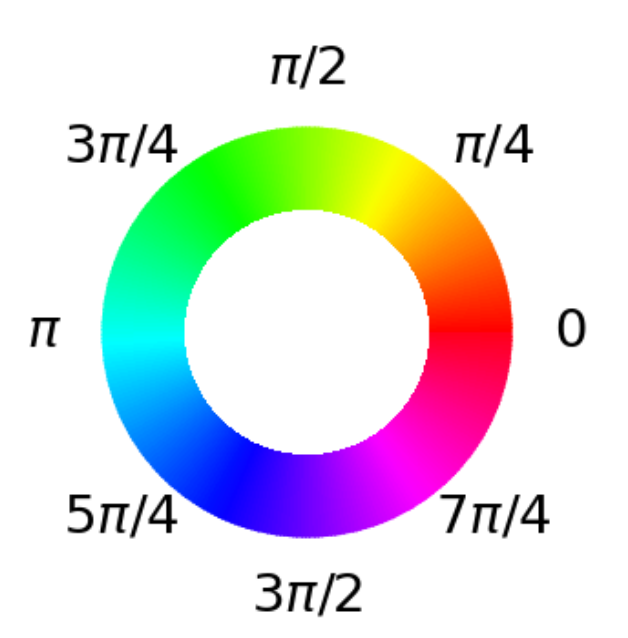Note
This page was generated from docs/tutorials/04_grover_optimizer.ipynb.
Grover Optimizer¶
Introduction¶
Grover Adaptive Search (GAS) has been explored as a possible solution for combinatorial optimization problems, alongside variational algorithms such as Variational Quantum Eigensolver (VQE) and Quantum Approximate Optimization Algorithm (QAOA). The algorithm iteratively applies Grover Search to find the optimum value of an objective function, by using the best-known value from the previous run as a threshold. The adaptive oracle used in GAS recognizes all values above or below the current threshold (for max and min respectively), decreasing the size of the search space every iteration the threshold is updated, until an optimum is found.
In this notebook we will explore each component of the GroverOptimizer, which utilizes the techniques described in GAS, by minimizing a Quadratic Unconstrained Binary Optimization (QUBO) problem, as described in [1]
References¶
Grover Adaptive Search¶
Grover Search, the core element of GAS, needs three ingredients:
A state preparation operator \(A\) to construct a superposition of all states in the search space.
An oracle operator \(O\), that recognizes the states of interest and multiplies their amplitudes by -1.
The Grover diffusion operator \(D\), that multiplies the amplitude of the \(|0\rangle_n\) state by -1.
While implementations of GAS vary around the specific use case, the general framework still loosely follows the steps described below.

GroverOptimizer uses QuadraticProgramToNegativeValueOracle to construct \(A_y\) such that it prepares a \(n\)-qubit register to represent the equal superposition of all \(|x\rangle_n\) and a \(m\)-qubit register to (approximately) represent the corresponding \(|Q(x)-y\rangle_m\). Then, all states with \((Q(x) - y)\) negative should be flagged by \(O_y\). Note that in the implementation discussed, the oracle operator is actually independent of \(y\), but
this is not a requirement. For clarity, we will refer to the oracle as \(O\) when the oracle is independent of \(y\).
Put formally, QuadraticProgramToNegativeValueOracle constructs an \(A_y\) and \(O\) such that:

where \(|x\rangle\) is the binary encoding of the integer \(x\).
At each iteration in which the threshold \(y\) is updated, we adapt \(A_y\) such that the function values are shifted up or down (for minimum and maximum respectively) by \(y\). For example, in the context of finding the minimum, as the value of \(y\) decreases, the search space (negative values) also decreases, until only the minimum value remains. A concrete example will be explored in the next section.
Find the Minimum of a QUBO Problem using GroverOptimizer¶
The following is a toy example of a minimization problem.
\begin{eqnarray} \min_{x \in \{0, 1\}^3} -2x_0x_2 - x_1x_2 - 1x_0 + 2x_1 - 3x_2. \end{eqnarray}
For our initial steps, we create a docplex model that defines the problem above, and then use the from_docplex_mp() function to convert the model to a QuadraticProgram, which can be used to represent a QUBO in Qiskit Optimization.
[1]:
from docplex.mp.model import Model
from qiskit.primitives import StatevectorSampler
from qiskit_optimization.algorithms import GroverOptimizer, MinimumEigenOptimizer
from qiskit_optimization.minimum_eigensolvers import NumPyMinimumEigensolver
from qiskit_optimization.translators import from_docplex_mp
/tmp/ipykernel_4134/2408476460.py:2: DeprecationWarning: Using Qiskit with Python 3.9 is deprecated as of the 2.1.0 release. Support for running Qiskit with Python 3.9 will be removed in the 2.3.0 release, which coincides with when Python 3.9 goes end of life.
from qiskit.primitives import StatevectorSampler
[2]:
model = Model()
x0 = model.binary_var(name="x0")
x1 = model.binary_var(name="x1")
x2 = model.binary_var(name="x2")
model.minimize(-x0 + 2 * x1 - 3 * x2 - 2 * x0 * x2 - 1 * x1 * x2)
qp = from_docplex_mp(model)
print(qp.prettyprint())
Problem name: docplex_model1
Minimize
-2*x0*x2 - x1*x2 - x0 + 2*x1 - 3*x2
Subject to
No constraints
Binary variables (3)
x0 x1 x2
Next, we create a GroverOptimizer that uses 6 qubits to encode the value, and will terminate after there have been 10 iterations of GAS without progress (i.e. the value of \(y\) does not change). The solve() function takes the QuadraticProgram we created earlier, and returns a results object that contains information about the run.
[3]:
grover_optimizer = GroverOptimizer(6, num_iterations=10, sampler=StatevectorSampler(seed=123))
results = grover_optimizer.solve(qp)
print(results.prettyprint())
objective function value: -6.0
variable values: x0=1.0, x1=0.0, x2=1.0
status: SUCCESS
This results in the optimal solution \(x_0=1\), \(x_1=0\), \(x_2=1\) and the optimal objective value of \(-6\) (most of the time, since it is a randomized algorithm). In the following, a custom visualization of the quantum state shows a possible run of GroverOptimizer applied to this QUBO.

Each graph shows a single iteration of GAS, with the current values of \(r\) (= iteration counter) and \(y\) (= threshold/offset) shown in the title. The X-axis displays the integer equivalent of the input (e.g. ‘101’ \(\rightarrow\) 5), and the Y-axis shows the possible function values. As there are 3 binary variables, there are \(2^3=8\) possible solutions, which are shown in each graph. The color intensity indicates the probability of measuring a certain result (with bright intensity being the highest), while the actual color indicates the corresponding phase (see phase color-wheel below). Note that as \(y\) decreases, we shift all of the values up by that amount, meaning there are fewer and fewer negative values in the distribution, until only one remains (the minimum).

Check that GroverOptimizer finds the correct value¶
We can verify that the algorithm is working correctly using the MinimumEigenOptimizer in Qiskit optimization.
[4]:
exact_solver = MinimumEigenOptimizer(NumPyMinimumEigensolver())
exact_result = exact_solver.solve(qp)
print(exact_result.prettyprint())
objective function value: -6.0
variable values: x0=1.0, x1=0.0, x2=1.0
status: SUCCESS
[5]:
import tutorial_magics
%qiskit_version_table
%qiskit_copyright
Version Information
| Software | Version |
|---|---|
qiskit | 2.1.2 |
qiskit_optimization | 0.7.0 |
| System information | |
| Python version | 3.9.23 |
| OS | Linux |
| Wed Aug 20 14:15:27 2025 UTC | |
This code is a part of a Qiskit project
© Copyright IBM 2017, 2025.
This code is licensed under the Apache License, Version 2.0. You may
obtain a copy of this license in the LICENSE.txt file in the root directory
of this source tree or at http://www.apache.org/licenses/LICENSE-2.0.
Any modifications or derivative works of this code must retain this
copyright notice, and modified files need to carry a notice indicating
that they have been altered from the originals.
[ ]: